Technology Status of Hydrogen Road Vehicles
Technology Status of Hydrogen Road Vehicles
Technology Status of Hydrogen Road Vehicles
Create successful ePaper yourself
Turn your PDF publications into a flip-book with our unique Google optimized e-Paper software.
The 11th WHEC shows increasing interest in FCs for transportation applications, but the ICE proponents are<br />
still forcefully present. Provenzano et al. (1996) report on successful ICE operation <strong>of</strong> three hydrogen trucks,<br />
as do Knorr et al. (1996) for a full-size city bus; Peschka (1996) favors a combination <strong>of</strong> early and late<br />
injection <strong>of</strong> LH 2 to reach comparable performance as gasoline, but with very low NO x; he finds the FC<br />
unattractive on a power/weight basis. Some major European car manufacturers such as Volvo (Ekdunge and<br />
Råberg 1996) and Mercedes (Dönitz 1996; Friedrich and Noreikat 1996) report favorably on FCs; Friedrich<br />
and Noreikat have been major developers <strong>of</strong> the hydrogen ICE, as summarized by Digeser et al. (1996).<br />
4.2 Fuel Cells<br />
The FC, like LH 2, was brought into widespread use in the space industry, and some versions have made<br />
enormous strides during the past 5-10 years. Appendix 3 introduces FCs, enumerates the ones receiving most<br />
attention in a general sense, and focuses on the two types <strong>of</strong> most interest for vehicles:<br />
! The proton exchange membrane (PEM) FC, which operates at low temperature (~80 o C), has reasonable<br />
efficiency (~55 %), starts up in seconds, has good dynamic response and a promising lifetime (~same as<br />
vehicle); it is emerging as the favorite FC for vehicles (see in Tables 1 and 2).<br />
! The alkaline fuel cell (AFC), which operates at about the same temperature as the PEM FC but with a<br />
liquid electrolyte and a lower power density.<br />
The main disadvantage <strong>of</strong> the PEM is its need for platinum (Pt) catalyst at the electrodes, at least an order <strong>of</strong><br />
magnitude greater than the Pt content <strong>of</strong> today’s catalytic converters for ICE mobile application. However,<br />
the need for Pt in the PEM FC is decreasing. Another disadvantage is the cost <strong>of</strong> the solid polymer membrane,<br />
which comes in several trademarked versions. But as Appleby (1992) points out, the basic polymer material<br />
is quite cheap.<br />
Dönitz (1996) states that in 1990 these two cost items were roughly equal per unit power output (320 DM/kW<br />
for Pt loading <strong>of</strong> electrodes, 250 DM/kW for Nafion membrane). He claims that the Pt loading has sunk to<br />
only 55 DM/kW in 1996, and can reach 6 DM/kW over the long run, making it no bar to commercialization.<br />
However, only volume production and/or the development <strong>of</strong> new polymers can bring down the cost <strong>of</strong> the<br />
membrane.<br />
Rusanov (1996) states that a Russian solid polymer membrane costs several times less than Nafion.<br />
Scherer et al. (1996) describe initial characterization tests on novel proton conducting membranes.<br />
Bevers et al. (1996) describe potential improvements in mass production <strong>of</strong> reproducible PEM electrodes.<br />
The AFC has different catalysts, and is intolerant to CO and CO 2. This may help explain its lack <strong>of</strong> favor:<br />
only two projects--now terminated--figure on Table 1, and none on Table 2.<br />
Although the PEM FC comes closest to the ICE on a specific power (kW/kg) basis, the 11th WHEC gives<br />
some conflicting figures:<br />
! Peschka (1996) claims that the hydrogen ICE will continue to enjoy the order-<strong>of</strong>-magnitude advantage<br />
it has over H 2-air FC: 1 kW/kg vs. 0.1 today, increasing to 1.8 versus 0.2<br />
! Ekdunge and Råberg (1996) give an ICE and an FC option for a five-passenger Volvo car: the 93-kW ICE<br />
weighs 1,450 kg; a 75-kW FC would weigh 1820 kg plus 123 kg <strong>of</strong> buffer batteries for the same total peak<br />
capability <strong>of</strong> 93 kW<br />
! Friedrich and Noreikat (1996) quote 20 kg/kW for the Mercedes Benz PEM FC <strong>of</strong> Item 9 Table 1, and<br />
claims that this can be improved by a factor 4 to 5; another author from the same company, Dönitz (1996)<br />
9













